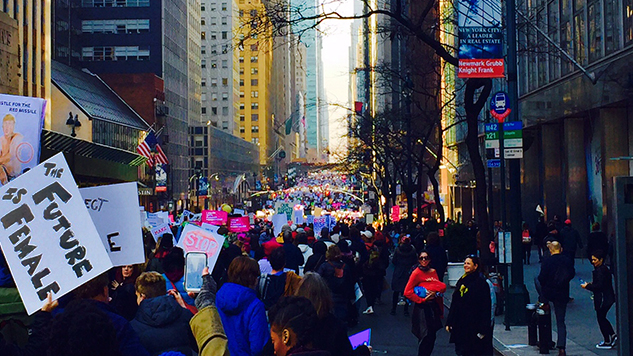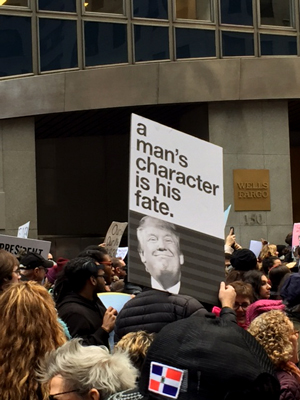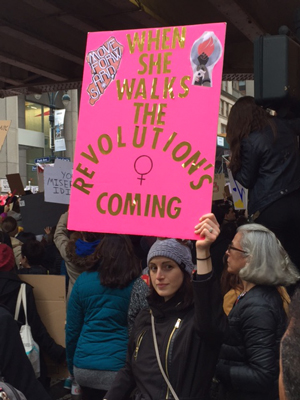A March in Search of a Metaphor: Women’s March NYC

The Women’s March ended for me like any other trip to New York City: with a stop at the restrooms on the lower level of Grand Central. The lines are always painfully long at the busiest train stations in the world, but on this day the wait was well understood. Once inside one woman, then another walked by out of the bathroom stalls. They didn’t have the patience to wait in the extremely long Women’s line. No one cared. A woman exited a men’s stall and I was reminded of the song “Androgynous” by the Replacements. Fittingly released in 1984 they raged “kewpie dolls and urine stalls will be laughed at the way you’re laughed at now.” It was a moment to wonder why, over 20 years later, some states still make serious policy issues out of which bathroom someone uses. This was supposed to be the future of unisex design. Of equality, equity. We’re not even close, which is why millions of people unified under the banner of the Women’s March.

The way I saw it, the main focus of marches across the country, including the Women’s Marc on NYC in which I participated, was to assert the rights of women under the administration of a pussy-grabbing misogynist sad-excuse of a man they call Trump. A man who just the day before was sworn in as President with a losing tally of popular vote. His campaign was a campaign of hate. Women—50% of the population—took the lead in asserting their rights. It started with the Women’s March on Washington D.C., and ended with marches taking place all around the world, even on the Antarctic Continent. But as with any large group, with every thousand new attendees the march’s goal grew. The official platform included: ending violence, reproductive rights, LGBTAQIA rights, worker’s rights, civil rights, disability rights, immigrant rights, and environmental justice. Whether or not you believe in safe spaces, the Women’s March was a place for everyone to be. It represented the work that can only be accomplished if the load is shared by everyone. This included the straight, white, cis-male.
“A compromise would be silence.”
—Amiri Baraka
As a SWCM myself, I didn’t march to assert my rights. They are guaranteed to me, and would have been at any time in American History. I went to march to support the assertions of people who do not fall into this large club. And despite reports that many men feared going to a place that wasn’t for them, we were welcomed. The strange narcissism of helping yourself and people that are like you will be a running theme of the current administration. That’s not to say the motivation is entirely altruistic. My fiancee is a woman; so are my grandmothers, my mother, future mother-in-law and sister-in-law, friends, co-workers. They are all very important to me, and I’ve seen them pushed-aside first hand. And while the role of the SWCM is secondary or even tertiary to Women’s Rights, it was a pointed message to this administration that just because we look like you doesn’t mean that we will stand behind you.

It was a day of pointed messages and signs. This group is a witty and creative bunch. The protest signs, a feature of any good march, have taken on a new tenor in the digital age. They are essentially memes to be shared, just in real life. Many attacked the exaggerated physical features of President Ugh: his sallow skin encrusted with orange tanner, his tiny hands, his combover, and his Trump. Some used his own phrases against him (“Sad!”), some were policy wonks (“Repeal the 8th”), and some were concerned mostly with Ancient Greek Philosophy (“A Man’s Character is His Fate”). There were at least five bands, one of which was the Lesbian and Gay Big Apple Corps marching band. And then there were the Pussyhats. New York City fashion, for at least a day, was dominated by a homemade crocheted or knitted square hats. A single item that represents a million chains tied together, all designed to be uniform while no two could possibly be exactly alike. Aerial photos of the worldwide events were awe-inspiring, to see so many come under one banner. The people and their messages were the heartbeat of this day of global gathering, driven by a commitment to principles, strong women taking the lead and men standing behind them. It was art, energy and movement created by a hell of a lot of people.
“Victory is won not in miles but inches.”
—Louis L’Amour
The estimates for NYC ranged from 150,000 expected to 600,000 on the high end. The official estimate given out by the NYC Press Secretary Eric Phillips put the number at 400,000. During the long jubilant day, people walked slowly for short periods of time but were often halted by the progress of those surrounding them. This resulted in a lot of marchers standing around, unsure of exactly what to do next but still elated to be there. In this way the Women’s March on NYC was like that L’Amour metaphor of old. Even those who simply stood still in solidarity with the global populist uprising inched forward to a much greater victory than the one Our Lady of Cheetos claimed for himself in November.

The next four years are not going to be easy for the people that attended the march in New York City or Washington D.C., or the marchers—if President Chester Cheetah makes good on his promise to undo NATO—in London, Paris, Vancouver, or really anywhere else. It’s like the country picked up a “move back three spaces card” in the game of life and it will be a slow and tiring effort to have to stand up for rights that felt close to real in the Obama administration. But it is work that must be done; when there are millions marching in solidarity, and when it is just you and your family making calls to swing state voters for the mid-term elections. It will be a long haul, but the one thing that is for sure, the Women’s March, not Trump, is moving in the right direction. And it is the women that will lead the way.
@chrisjohngilson is not dead, he writes about music for Pancakes & Whiskey, and his work has appeared in the New York Times, Paste, Splitsider, and elsewhere.







































